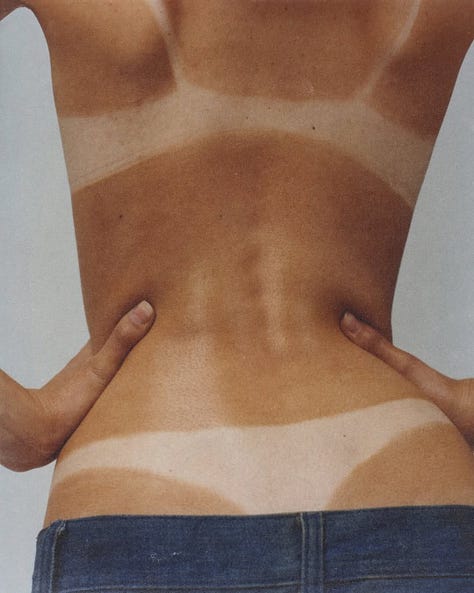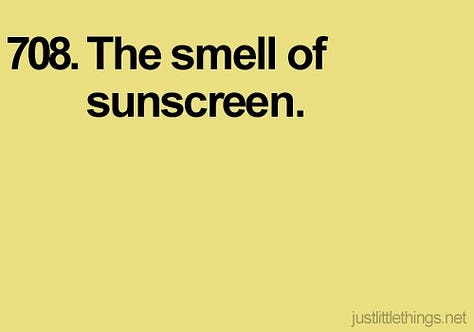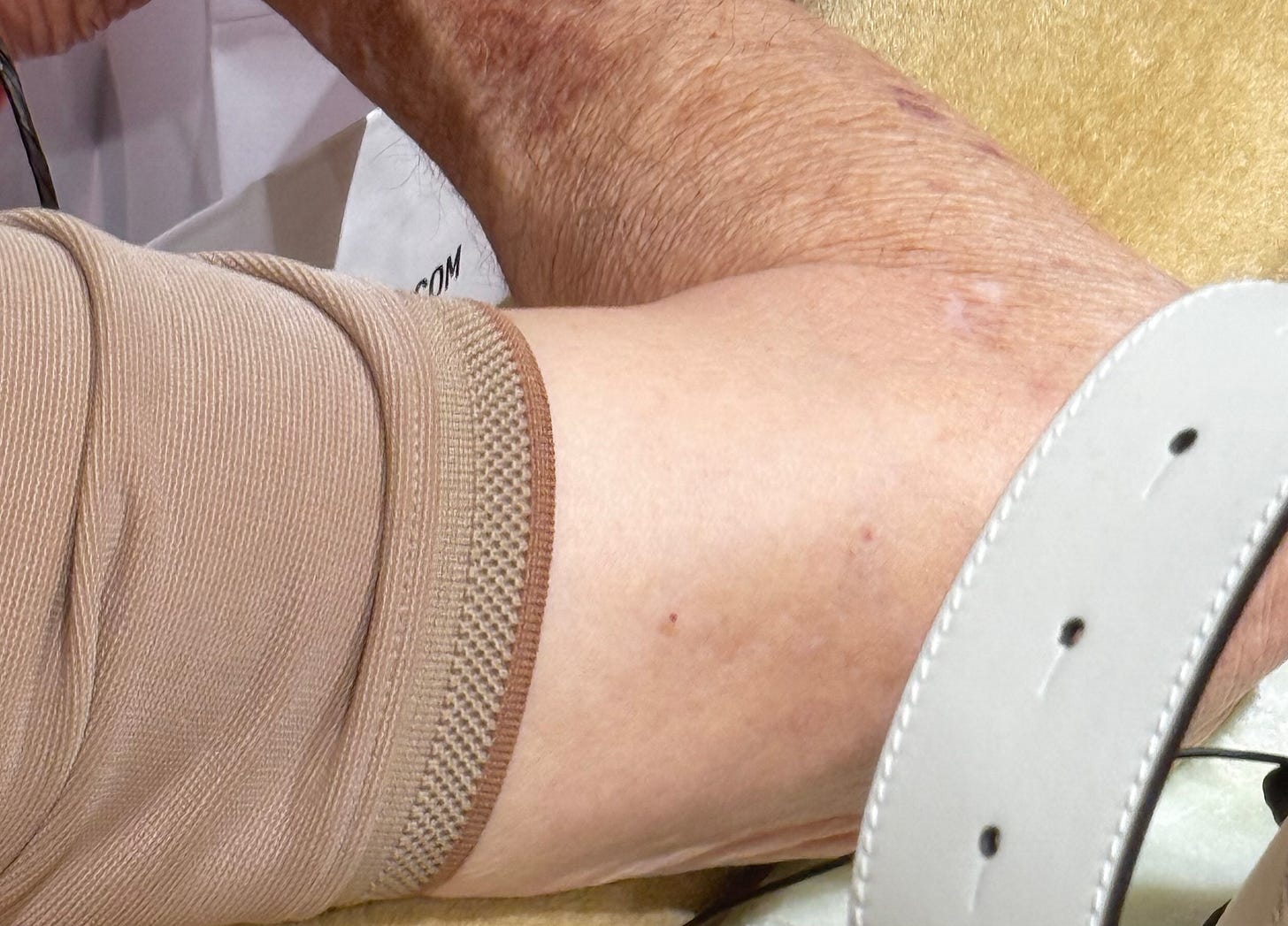Hi angels!
Remember when I mentioned working on an ultimate sunscreen guide in my last newsletter? Well, it's finally here! After weeks of thoroughly testing formulas and compiling a spreadsheet, I've created what I hope will be your honest and real resource for all things SPF.



This google sheet is a living document, I only added sunscreens that I personally deemed most relevant in terms of performance or hype, and will add more over time. So good ones, interesting ones but also some bad ones for contrast, in my opinion there are a lot of medium performing, uninteresting sunscreens out there. So I didn’t want to add all of those right now. Please let me know in the comments which ones you want me to review and add to the ever growing google sheet!
With summer being here (and sun damage happening year-round, let's be honest), I wanted to cut through the noise and give you some nuance and more layered (re)views. Especially with social media’s sunscreen fear-mongering reaching absolutely wild proportions lately.
I'm extremely excited to share my complete SPF vetting system Google sheet with you! It's a labor of love I've put together after countless hours of research, and it'll be available for all my wonderful paid subscribers.
My little corner of Substack has been free to read since day one, but I'm making a gentle shift today. You'll still get free newsletters sprinkled throughout (or partially free ones like this!), but most of my deep-dive content will be for paid subscribers.
I pour my whole heart into these newsletters - researching late into the night, drafting and redrafting until everything feels just right. If you've found value in my writing and want to support this work, becoming a paid subscriber is the cosiest way to do that!
A monthly subscription (€6,70/month) is way cheaper than a premium sheet mask or lip balm, a yearly subscription (75€) costs way less than a facial. There is also a special 22% introduction discount for yearly memberships, only valid for the next 48 hours, which means you’ll pay only €59 a year for the rest of eternity.
If you choose to become a founding member (11€ a month - only yearly memberships), you’ll also get access to my Soft Glow GPT, which is basically my values, my brain, my POV on beauty and cosmetics uploaded, a GPT you can ask for way more than just product advice. She’s almost 1 year old now, and has received a lot of great feedback! (access will be manually, with a seperate email, asap)
It means the absolute world to me to build this community with you. <3
SUNSCREEN IN THE NEWS
There has been a lot of noise around sunscreen testing by consumer collectives lately. Some sunscreens with high SPF’s have been tested to not live up to their sun protection number on their bottle. We’re not quite sure yet if this is because of decanting during testing or other factors. Until the verdict is there (more research is needed), i’m not gonna conclude anything sensationalist. But until then, even more reason to layer up and use enough, since most of us heavily under apply.
16 of 20 sunscreens didn’t meet SPF claims in CHOICE test, CHOICE Australia
the rules, the basics, know them at heart <3
FACE: you’ll need 1/4 teaspoon for your face, this does not include your neck. some people measure 1/4 with 2-3 full fingers. but the line on your fingers needs to be thick, and this depends on the formula. better to use a measuring spoon!
BODY: one teaspoon for each arm, leg, front of torso, back of torso and head/face/neck/ears.
REAPPLICATION: it depends. It is mostly about the sunscreen film clumping up and wearing off over time. A good rule of thumb is to reapply every 2 hours, or earlier after you’ve been sweating / swimming etc.
WAIT at least 15 MINUTES between layers: your sunscreen needs to form a film before you (or your make up brush) touch it. Depending on formula, this can take between 5 to 15 minutes.
DON’T JUST RELY ON SPF:
UV RAYS CAUSE PREMATURE SKIN AGING (or worse: cancer).
I’m sorry to do this to you on this pristine Sunday morning. But I want you to see what I saw in Galeries de Lafayette last week in Paris. I hope this image will haunt you in the most constructive way possible. THIS is the difference in skin age when you expose your skin fully, or protect it (in this case with clothing I assume):
I hope I made my point now. The sun is our friend, but can be a toxic friend sometimes!
what I want you to know about sunscreen
1. sunscreen is not "toxic"
Despite what you’ve heard in this terrifying age of clickbait, virality and misinformation: sunscreens are among the most highly regulated cosmetics worldwide. Every active ingredient - from zinc oxide to avobenzone - must pass rigorous safety and efficacy tests before it ever reaches lab shelves. Not just singular ingredients but also the full formula needs to pass those rigorous tests.
Social media creators claiming that sunscreen "poisons" you? That is pure sensationalism, often fuelled by cherry-picked data and zero context. They often have something to sell as an alternative, I always do this little game with myself to figure out their agenda and up until now money or going viral (= also money) has been the case 100% of the time. I've watched so many of these videos with my eyes tired from rolling, wondering if I'm somehow living in a parallel universe where basic scientific literacy doesn't exist.
some reminders: the dose makes the poison, everything is toxic in a certain dose, your skin is not your mouth, the sun is our biggest friend and enemy at the same time, beef tallow influencers are a red flag.
Broad-spectrum sunscreens block BOTH UVA and UVB rays. The only toxicity you should worry about is sunburn-induced DNA damage. That's the real villain here, not your La Roche-Posay fluid.
2. the real problem: under-application & infrequent reapplication
Most people slather on a thin veil of SPF, pat themselves on the back, then never touch up - despite spending hours outdoors. That's not enough. Or other people only use SPF on beach days.
I used to be guilty of this too! I'd apply the tiniest dot of sunscreen, convinced I was protecting my skin, then wonder why I still had sun spots popping up. I was uninformed. The truth is not pretty: most of us are wearing what amounts to SPF 5-10 in real life, not the SPF 50 on the bottle.
TIP: don’t transfer your sunscreen into a different bottle. Decanting can alter the formula's stability and ruin its performance. Packaging compatibility testing exists for a reason. Those cute refillable containers might be great for your body lotion but keep your sunscreen in its original packaging, unless you want to dabble in the risk of using SPF 5 in stead of 50.
3. training your skin to get used to the sun without using sunscreen is quite dumb
Listen, I've heard this "skin training" theory float around TikTok lately, and I need to lovingly put this myth to bed. Your skin doesn't "learn" to protect itself with repeated UV exposure. What's actually happening is cumulative damage to your DNA and collagen. Each "training session" is just your skin cells frantically producing melanin as an emergency response while sustaining mutations that could lead to skin cancer. Trust me, your 55-year-old self will be infinitely grateful you chose sunscreen over "sun training": both your health and your future selfies depend on it.
4. mineral sunscreens are not better than chemical sunscreens
Both mineral and chemical sunscreens have their merits and their drawbacks.
Mineral: Generally speaking: less irritation for eyes and highly sensitive skin, often preferred by those with rosacea or post-procedure skin. My skin certainly prefers a few mineral formula’s when it's having a tantrum, but also here: it depends on the formula. some mineral SPF’s can break me out, others irritate my skin (I’m looking at you Fenty, although like many modern mineral products, they claim to be 100% mineral but are not. more about that in a sec.).
Mineral sunscreen MYTH: “mineral sunscreen is better for the environment.” no it is not. Zinc oxide has worse environmental impacts than many chemical sunscreens. Natural substances still have impacts. Zinc oxide has particularly big impacts during production, and is classified as toxic to aquatic life.
Mineral Con’s: Virtually every 100% mineral formula leaves an insulting white cast on deeper skin tones - SOME tinted mineral options (e.g., Fenty) can help but most of the time it doesn’t make any difference. And honestly? Even on my pale skin, some mineral formulas make me look like a Victorian ghost. SO many “clean” brands are lying about this. Alll the time. I am so tired. Bring me to bed already. Could you imagine how tired people with more melanated skin are regarding the gaslighting of these “clean” beauty brands??
Chemical: Lightweight, invisible finish, easier to layer under makeup. These are my go-to for everyday city life, but also on the beach! All the fear mongering around these is based on extremely wide spread misinformation coming from badly done + badly interpreted studies. “But what about product accumulation?” Lucky for us, that is (wildly!) being taken into account by scientists.
I just get so sad that even people like Dr. Andrew Huberman tell their huge audiences regularly that they prefer mineral sunscreens. I know it seems like an innocent (it’s not) and that it’s not his expertise, but I thought he would understand how sharing something that is based on fear mongering trickles down and snow balls, especially in this time and age.
Chemical SPF con’s: Can sting around eyes, in my personal experience that is mostly the case with older generation chemical filters (like the ones legal in the US). American chemical filters are also usually more heavy, thick in formula. But the modern chemical filters that are allowed in Europe and Asia are absolutely amazing! I feel like they sting my eyes less intensely, but I still need to find a liquid formula that doesn’t sting my eyes at all. Of course Eye stinging depends on the formula. And Eye stinging can be personal! I believe that some sunscreen formulations sting everyones eyes, and some formulations sting only some people’s eyes. You can check for formulations with eye stinging tech (La Roche Posay), but in my case that doesn’t fully solve it for me.
PRO TIP: use a balm stick around the eyes. This can also be a lip balm with SPF50. another thing I do is powder the SPF or use a setting spray to keep the SPF from moving into your eyes.
Bottom line: It's all about the formula. Don't swear off an entire category, swear off shitty formulations. I switch between both depending on my skin's needs and what I'm doing that day. But that being said, 95% of mineral sunscreens are just very very bad in terms of texture, absorption and white cast. And the gaslighting of POC? not cute at all, to say the least. Brands need to take a look in the mirror and do better.
5. natural sunscreen does not exist
also behind this paywall:
the ultimate sunscreen review google sheet, reapplying SPF over makeup without ruining your look, the biggest sunscreen myth currently making rounds, why I ditched apps like Yuka, thoughts on the DIEUX sunscreen analyser, ultimate overview with links to sunscreen myth’s debunked + the real science, actually wearable UV clothing options, and some tea on influencer misinformation (including Dutch creators that I’ve had enough of, I’m sorry)










